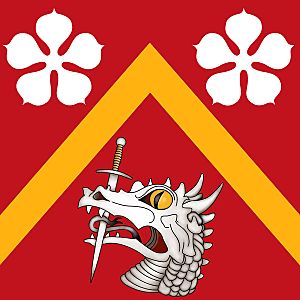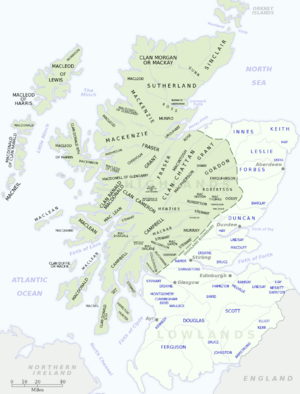Clan Duncan facts for kids
Quick facts for kids Clan Duncan |
|||
|---|---|---|---|
| Dunchad / Donchadh / Donnachadh | |||
| Profile | |||
| Region | Perthshire, Tayside, Angus, Fife, Aberdeenshire. | ||
| Clan Duncan has no chief, and is an armigerous clan | |||
|
|||
The name Duncan is very old in Scotland. It comes from the Gaelic word Dunchad or Donnchadh. You can find this name in Scotland's earliest records.
Contents
The Beginnings of the Duncan Name
The name Duncan, or Dunchad, was first a personal name. It is one of the oldest names in Scotland. It comes from the Celtic Scots who came from Ireland. They settled in southwest Scotland around the 4th century AD. One early leader was Dúnchad (Duncan mac Conaing). He ruled a part of Scotland called Dalriada from about 650 to 654 AD.
The name Duncan also appears on a very old stone from the 4th century AD. This stone is called the 'Turpillian Stone' and is in Wales. It has writing called Ogham, which is an early Celtic script. It also has a Latin translation that means 'The Fort Warrior'. The name Duncan was also used for important religious leaders. For example, Dunchad (Duncan) was the 11th Abbot of Iona from 707 to 717 AD. Another Dunchad was the 39th Abbot in 989 AD.
Not many records exist from this very early time. But after Kenneth MacAlpin united the Celtic Scots and the Picts around 843 AD, the name Duncan started to appear more often. One of the first mentions of Dunchad or Donchad is in the Book of Deer. This book is from the 11th century. It contains some of the oldest writings in Scots Gaelic. These writings were made by monks at the Abbey of Deer in Aberdeenshire.
Kings Named Duncan
When Duncan I became King of Scotland, he was a young man. He became king after his grandfather, Malcolm II, died in 1034. It seems he became king without any problems. However, by 1040, Duncan I was defeated in battle. The crown then went to Macbeth.
Fifty-four years later, Duncan II also died because of his relatives. Even though Duncan II had a son, his younger half-brother took the throne. This half-brother was one of the children of Queen Margaret.
Later Mentions of Duncans
Later, in 1296, a person named Ewyn (Ewan) fitz Duncan signed 'The Ragman Rolls'. This was a document where Scottish nobles promised loyalty to Edward I of England.
In 1367, John Duncan owned property in Berwick. The mayor of Berwick at that time was John Duncanson, who was likely John Duncan's son.
Some stories say that a clan called Clan Donachie or Donnachadh appeared in the early 14th century. This clan is said to have come from the Earls of Athole. The clan name might come from Donnachadh Reamhar, which means 'Stout Duncan'. Legend says this chief led his clan into the Battle of Bannockburn in 1314. Both the Duncans and the Clan Donnachaidh (also known as Robertsons) are believed to be related to the 4th Donachie/Donnachadh Chief.
The Duncans of Lundie
The most important Duncans in eastern Scotland were the Duncans of Lundie. Their lands included the Barony of Lundie and the estate of Gourdie in Forfarshire. In 1764, Sir William Duncan, who was a doctor to King George III, was made a Baronet. He was the first and last Baronet of his line.
By 1795, Adam Duncan of Lundie became a very important naval officer. He was the Commander of the Fleet in the North Sea. He was also an Admiral of the Blue. He had many victories and was made the 1st Viscount Duncan of Camperdown in 1797. His son became the 2nd Earl of Camperdown in 1831. This title ended in 1933. Today, the Duncan name is most common in Aberdeenshire, Dundee & Angus, and Fife.
Duncan Castles
- Lundie Castle used to be seven miles southeast of Coupar Angus. Sadly, nothing remains of it today. The Duncans owned these lands, and many of them are buried in the nearby Lundie churchyard. The original castle was taken down and replaced by a house in the 1600s. That house was also later removed to build the mansion you see today.
- Camperdown House was built by the Duncans in the 1800s. It sits on four hundred acres of park land. Today, the grounds are a public country park. There were plans to create a museum at Camperdown House. This museum would tell the story of Adam Duncan, 1st Viscount Duncan and his victory at the Battle of Camperdown.
Duncan Family Branches
Here are some of the notable Duncan family branches:
- Duncan of Seaside & Lundie (Camperdown)
- Duncan of Jordanstone
- Duncan of Ardownie
- Duncan of Sketraw
- Duncan of Mott
- Duncan of Parkhill
- Beveridge-Duncan of Damside
- Gomme-Duncan of Dunbarney
Clan Duncan Today

Clan Duncan is an armigerous clan. This means the clan has a coat of arms, but it does not have a recognized chief right now. Currently, the clan is led by the Territorial House of Duncan of Sketraw. Their coat of arms and territorial designation are officially recorded in Scotland.
The Clan Duncan Society wants to have a chief with the Duncan name. This chief would be officially recognized by the Lord Lyon King of Arms. They hope to find someone with a proven family link to the last chief from around 1434. Or, they might use a special process called derbfine to get a chief officially recognized.
Clan Duncan Tartans
There are two main tartans associated with Clan Duncan:
- Duncan or Leslie of Wardis This is the oldest clan or family tartan, dating from around 1880. It's not fully known why it's also called "Leslie of Wardis." However, it has always been known as the Clan Duncan tartan.
- Thread Count: K/8 G42 W6 G42 B42 R/8 (This is a technical pattern for weaving the tartan).
- The Duncan of Sketraw This clan or family tartan was designed in 2005. Brian Wilton of the Scottish Tartans Authority created it.
- Thread Count: R/4 K12 G4 K4 G28 K2 Y4 K2 B10 R2 B10 K2 W4 K2 G28 K2 B/4 (This is also a technical pattern for weaving).
The ancient kilt style is not shown here.
See also
- Duncan (surname)
- Clan Donnachaidh




